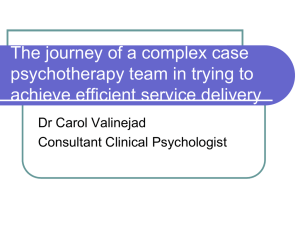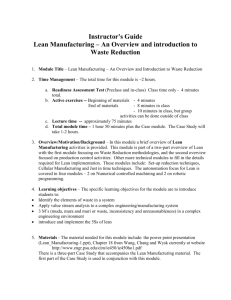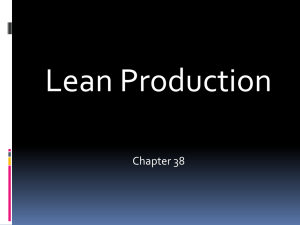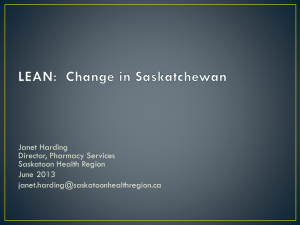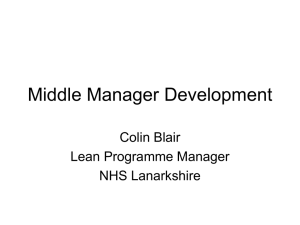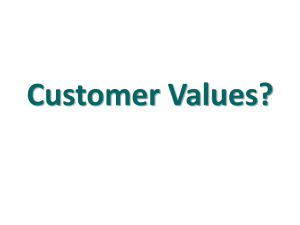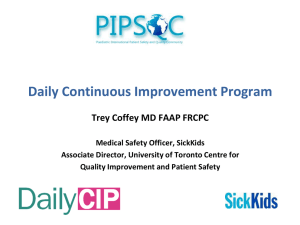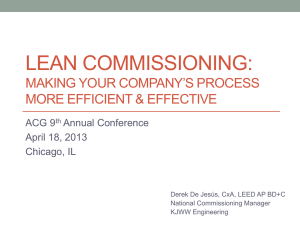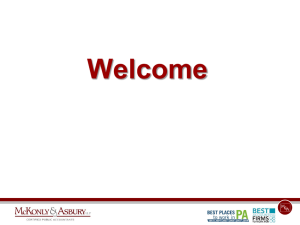Identifying and Writing a Problem Statement
advertisement
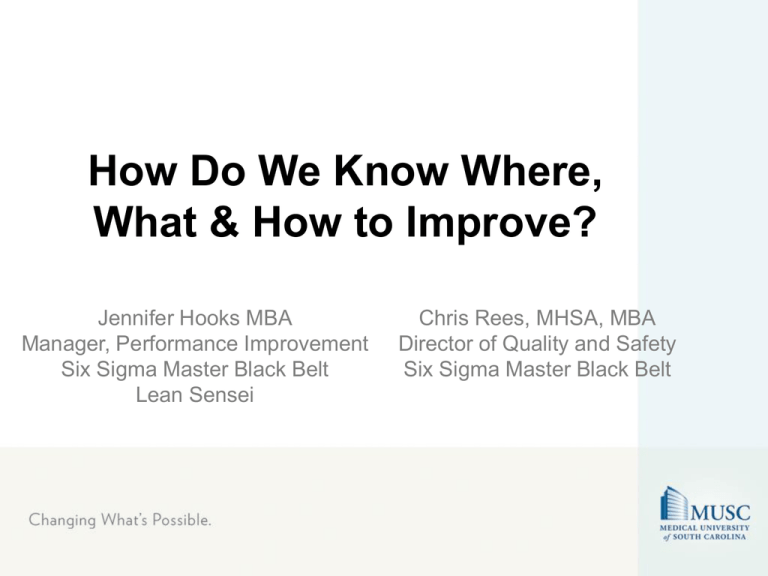
How Do We Know Where, What & How to Improve? Jennifer Hooks MBA Manager, Performance Improvement Six Sigma Master Black Belt Lean Sensei Chris Rees, MHSA, MBA Director of Quality and Safety Six Sigma Master Black Belt Objectives • • • • Overview of Performance Improvement Introduction to LEAN thinking Learn How to Pick a Successful Project Define What Makes a Good Problem Statement • Illustrate the Importance of Measurement • Group Work - Define a Project to Address Your Business Problem How To Improve? There is no magic answer Despite What the Book Sellers will Tell you How to Improve? No Magic Answer, but some basic must haves: • Use a Standard, Disciplined Approach. • Focus on: – Reducing Waste and Inefficiencies, – Reducing Variation and Eliminating defects. Basics of All Approaches • Use a team – Trust the Group • Clearly identify what it is you are trying to improve – Define your process & metrics • Measure and analyze data, both Quantitative and Qualitative • Focus only on the important issues • Validate that the results met your objectives • Have a plan to sustain results Going Lean Can it work for the Medical University? What is Lean? •The relentless pursuit of the perfect process through waste elimination… We Spend 75-95% of Our Time Doing Things That Increase Our Costs and Create No Value for the Customer! In healthcare, Lean is about shortening the time between the patient entering and leaving a care facility by eliminating all nonvalue added time, motion, and steps. What Lean is not • Layoffs • Customers = widgets • Making people work faster • Short term cost reduction program Origins of Lean • Henry Ford, 1920s • Continuous Flow Assembly • Reduce wasted time – 1913-1914: doubled production with no increase in workforce – 1920-1926: Cycle time from 21 days to 2 days Origins of Lean • Taiichi Ohno (1912-1990) • 1950’s: Toyota Production System – Continuous Flow Production – Just-in-Time (JIT) – Eliminate defects – Eliminate “MUDA” – Top management commitment – Employee participation Lean Thinking Process The 5 steps to Lean Thinking … Specify value from the customer’s perspective and express value in terms of a specific product 1 Specify Value The complete elimination of waste so all activities create value for the customer 2 Map the Value Stream 3 Establish Flow 5 Work to Perfection Nothing is done by the upstream process until the downstream customer signals the need Map all of the steps…value added, non-value added and…non-value added required that bring a product of service to the customer 4 Implement Pull The continuous movement of products, services and information from end to end through the process What are your customers willing to pay for? Who Is the Customer? VA NVA-R NVA 1 Specify Value • Value is determined by the customer – The customer must be willing to pay for the activity – The activity must change the form, fit or function of the service or product – The activity must be done right the first time 2 Map the Value Stream 3 Implement Pull • Produce work when initiated by customer demand • Smooth communication between process steps • http://www.youtube.com/watch?v=0 YGF5R9i53A&feature=related 4 Establish Flow • Remove non-value-added activities (wastes) from the process • Keep work moving at all times • Eliminate congestion Identifying Wastes Transportation Inventory Motion Waiting Overproduction Over Processing Defects Non-utilized Talent Moving equipment to different meeting rooms. Overfilled stationery cupboards. Medical students walking from wards to lecture theatres. Students queuing to register at start of term. Printing out multiple copies of meeting minutes already sent electronically. Too many meetings and committees Students being given incorrect exam marks Underutilizing people’s knowledge and creativity Moving forms between HR and other departments. Stockpiling headed notepaper Forms moving around internal mail Waiting for exam results. Printing unnecessary documents Several colleagues checking the same paperwork. Incorrect expenses being paid to staff Uneven work flow resulting with some team members overburdened while other underutilized Retrieving or storing files Excessive books in the library. Poor office layout and design located far from printer etc. Sitting in a meeting room, waiting for meetings to start because people are late. Offering courses that nobody applies for Repeated manual data entry Data entry errors. Moving documents to and from shared equipment Out of date equipment that is still stored. Searching for files. Waiting for signatures. Students graduating in subjects in which there are no jobs. Keeping local databases which replicate University databases Incomplete forms. Same document going back and forth from one office to another to review Listing courses in UCAS that are set to 0. Meetings instead of telephone calls Waiting for faxes. Producing reports that nobody reads Sending Reply all e-mail Out of date mailing lists etc. Waiting for a printer to be repaired Overly scrutinising work when key stakeholder has approved it Unused records in the database. Inaccurate advice given to staff and students. 5S Philosophy: Organize the Workplace Sort, Set, Shine, Standardize, Sustain • A visually-oriented system for organizing the workplace to minimize the waste of time. • Clears the clouds – Eliminates the waste of motion/ looking for things • Makes the abnormal visually obvious Step 1: Sort Before After Separate the needed from the not needed Step 2: Set BEFORE AFTER A place for everything & everything in its place! Step 3: Shine “Shine” and inspect equipment to ensure it is in perfect working condition... Add inspecting equipment into your work routine. Daily housekeeping is important. Regularly “shine” to ensure everything is in perfect working condition and clean Step 4: Standardize Note: Blue taped outlines and labels ensure equipment is quickly found and returned to the same spot every time. Standard Work requires determining the best method then following that method every time. Step 5: Sustain Develop a method for sustaining your gains 5 Work to Perfection • A continual, never-ending journey • Constantly work on shortening work cycle • Quality and Quantity • Focus on what the customer values Lean Goals • Build trust by removing fear • Initiate long-term cultural change • Communicate the vision to all staff • Active commitment of leadership is a must, in both words and action How to Pick a Project Criticality Critical to the Customer *Customer Satisfaction* Voice of the Customer • Identify the customer. Who is the recipient of the output? • Is the customer internal or external? Understand that internal customer satisfaction impacts external customer satisfaction. • Identify customer decision criteria. CQFA – cost, quality, features, availability. Is anybody listening? Criticality Critical to the Business *Revenue Growth, Economic and Market Value* Voice of the Business • Strategic • Identify and prioritize improvement initiatives to achieve strategic goals and objectives • Operations • Risk management internal enabling processes that can affect overall performance • Reporting • Corporate dashboards/balanced scorecards measure efficiency and effectiveness • Compliance • Regulatory compliance Listen to Mission, Vision, Goals Mission Improve health and maximize quality of life through education, research and patient care GOALS • • • • Interprofessional/Interdisciplinary Practices Technology/Innovation Entrepreneurialism Globalization Root Cause Solution Unknown Pick a problem that does not already have a known root cause or solution Well Managed Scope Large enough to significantly improve the process, but still small enough to be manageable Project should be within your control to make the recommended changes in order to improve the process Select a project that can be completed in a reasonable period of time (3 months to 6 months max) Chronic Issue Select a problem that happens often It is not worth the time and effort to develop a solution for a problem if it is unlikely to happen again Difficult to collect past data to analyze the causes because the problem occurred only once in the past Good Leadership Support Essential support from MUSC leadership goes beyond providing teams with the needed resources (time, money, people, etc.) Ensures ongoing comprehensive communication throughout the entire organization for the life of the project—beginning to end Execute the IMPROVE Methodology IMPROVE Roadmap Important to YOU!! Passionate, Interesting and Exciting Exercise Group Work - Define a Project to Address Your Business Problem Define the Problem • Initial Questions to Ask: – – – – – What is the problem? What is the benefit of reducing the impact of this problem? What is the Measurement? Who is my customer? What matters to them? • How do they define quality – What is the scope? • You can’t solve World Hunger! – What is a reasonable goal, a definition of success? • Remember your goal should be S.M.A.R.T. – Specific, Measurable, Achievable, Relevant, and Time bound Exercise • Work at your tables to answer the questions from the last slide and create a problem statement for this case study – A problem statement has the form: • • • • WHAT is wrong WHERE it happened WHEN it occurred Why is this a problem – A problem statement: • Does not include causes of the problem. • Does not include likely actions or solutions. • Is clear, concise, and specific.


